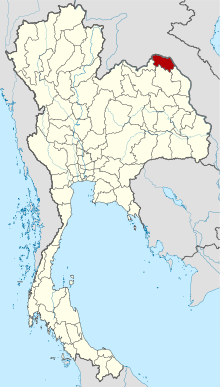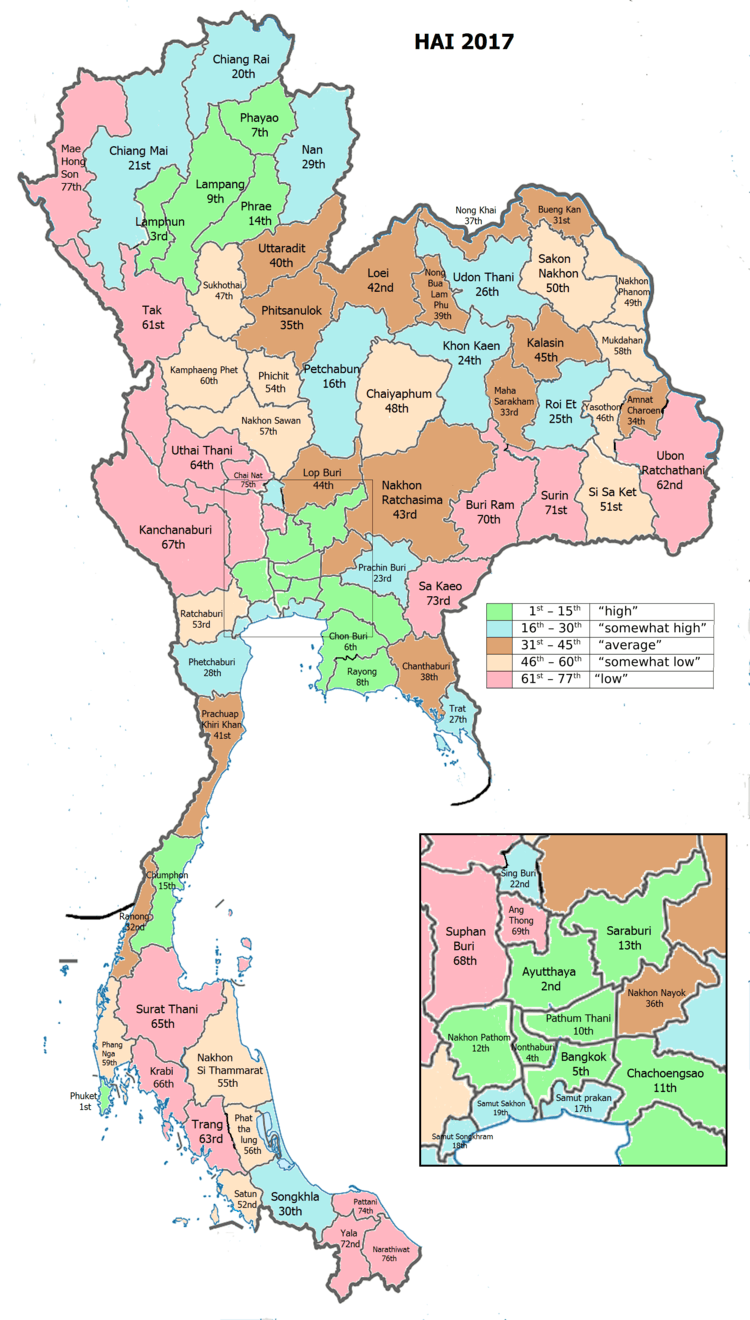Bueng Kan Province
Bueng Kan (Thai: บึงกาฬ, RTGS: Bueng Kan, pronounced [bɯ̄ŋ kāːn]), also spelled Bung Kan,[6] is the 76th province (changwat) of Thailand, established by the Act Establishing Changwat Bueng Kan, BE 2554 (2011) on 23 March 2011.[7] The province, consisting of the districts (amphoe) partitioned off Nong Khai Province, lies in upper northeastern Thailand also called Isan (Thai: อีสาน). It is named after its central district, Mueang Bueng Kan.
Bueng Kan บึงกาฬ | |
|---|---|
View of a cliff side at Phu Thok | |
 Flag  Seal | |
| Motto(s): "ภูทอกแหล่งพระธรรม ค่าล้ำยางพารา งามตาแก่งอาฮง บึงโขงหลงเพลินใจ น้ำตกใสเจ็ดสี ประเพณีแข่งเรือ เหนือสุดแดนอีสาน นมัสการหลวงพ่อใหญ่ ศูนย์รวมใจศาลสองนาง" ("Phu Thok, the source of dharma, Value of rubber, Kaeng Ah Hong beautiful, Bueng Khong Long fascinated, Clear seven color waterfall, Boat race traditions, Northernmost northeast region, Worship Luang Pho Yai and Two Nang Court Shrine") | |
 Map of Thailand highlighting Bueng Kan Province | |
| Country | Thailand |
| Created | 23 March 2011 |
| Capital | Bueng Kan |
| Government | |
| • Governor | Sanit Khao-ard (since October 2019)[1] |
| Area | |
| • Total | 4,306 km2 (1,663 sq mi) |
| Area rank | Ranked 52nd |
| Population (2018)[3] | |
| • Total | 423,940 |
| • Rank | Ranked 62nd |
| • Density | 99/km2 (260/sq mi) |
| • Density rank | Ranked 50th |
| Human Achievement Index | |
| • HAI (2017) | 0.5942 "average" Ranked 31st |
| Time zone | UTC+7 (ICT) |
| Postal code | 38xxx |
| Calling code | 042 |
| ISO 3166 code | TH-38 |
| Website | www |
| Bueng Kan Province area[5] | |
Geography
The province is in the northeastern corner of Thailand. It borders, from the south clockwise, Nakhon Phanom, Sakon Nakhon, and Nong Khai Province. To the north and east it borders Bolikhamsai Province of Laos, with the Mekong River forming the boundary.
In Bung Khla district is the Phu Wua Wildlife Sanctuary, protecting forest-covered hills close to the Mekong River.
History
In 1994, Sumet Phromphanhao, a member of the House of Representatives from Nong Khai Province, proposed that the province of Bueng Kan be established by consolidating the Bueng Kan, Seka, So Phisai, Bung Khla, Bueng Khong Long, Pak Khat, Phon Charoen, and Si Wilai Districts of Nong Khai Province as a new province. The new province, if created, would be 4,305 km2,[8] with a population of about 390,000 inhabitants.[9] At that time, the Ministry of Interior replied that creating a new province would load a heavy burden to the state budget and was contrary to the resolution of the Council of Ministers.[10]
The proposal to create Bueng Kan Province was tabled for about 20 years, until 2010 when the Ministry of Interior renewed the project and made a proposal to the Council of Ministers to have a "Bill Establishing Changwat Bueng Kan, BE..." (Thai: ร่างพระราชบัญญัติจัดตั้งจังหวัดบึงกาฬ พ.ศ....) considered.[9] In a poll at the time, 99 percent of the inhabitants of Nong Khai Province supported the proposal.[9] On 3 August 2010, the Council of Ministers resolved to present the bill to the National Assembly,[11][12] citing that the proposal met its criteria for approval.[13]
On 7 February 2011, the National Assembly approved the bill.[14] Prime Minister Abhisit Vejjajiva presented it to King Bhumibol Adulyadej for royal assent. Bhumibol Adulyadej signed the bill on 11 March 2011, enacting it as the "Act Establishing Changwat Bueng Kan, BE 2554 (2011)" (Thai: พระราชบัญญัติตั้งจังหวัดบึงกาฬ พ.ศ. 2554). The act was published in the Government Gazette on 22 March 2011 and came into force the next day.[7]
Provincial seal
The provincial seal of Bueng Kan, Thailand's 76th and newest province, has a depiction of Phu Thok, a mountain in Si Wilai District, an Isan language name which means "Lonely Mountain".[15]
The provincial flower and tree is Bauhinia sirindhorniae K. and S.S. Larsen.
Climate
Bueng Kan’s climate consists of a wet season and a dry season (between December and January). The temperature decreases during November and is at its lowest in December and January. The temperature quickly increases in March, and peaks in April.[16]
Administrative divisions

provincial government
The province is divided into eight districts (amphoe). The districts are further divided into 53 subdistricts (tambon) and 615 villages (muban).
Local government
As of 26 November 2019 there are[17]: one Bueng Kan Provincial Administration Organisation (ongkan borihan suan changwat) and 18 municipal (thesaban) areas in the province. Bueng Kan has not town (thesaban mueang) status, 41 subdistrict municipalities (thesaban tambon). The non-municipal areas are administered by 60 Subdistrict Administrative Organisations - SAO (ongkan borihan suan tambon).[3]
Human achievement index 2017
| Health | Education | Employment | Income |
| 2 | 71 | 61 | 61 |
| Housing | Family | Transport | Participation |
 |
 |
 |
|
| 5 | 6 | 57 | 38 |
| Province Bueng Kan, with an HAI 2017 value of 0.5942 is "average", occupies place 31 in the ranking. | |||
Since 2003, United Nations Development Programme (UNDP) in Thailand has tracked progress on human development at sub-national level using the Human achievement index (HAI), a composite index covering all the eight key areas of human development. National Economic and Social Development Board (NESDB) has taken over this task since 2017.[4]
| Rank | Classification |
| 1 - 15 | "high" |
| 16 - 30 | "somewhat high" |
| 31 - 45 | "average" |
| 45 - 60 | "somewhat low" |
| 61 - 77 | "low" |
| Map with provinces and HAI 2017 rankings |
 |
Notes
Reports (data) from Thai government are "not copyrightable" (Public Domain), Copyright Act 2537 (1994), section 7.
References
- "ประกาศสำนักนายกรัฐมนตรี เรื่อง แต่งตั้งข้าราชการพลเรือนสามัญ" [Announcement of the Prime Minister's Office regarding the appointment of civil servants] (PDF). Royal Thai Government Gazette. 136 (Special 242 Ngor). 12. 28 September 2019. Retrieved 24 November 2019.
- Advancing Human Development through the ASEAN Community, Thailand Human Development Report 2014, table 0:Basic Data (PDF) (Report). United Nations Development Programme (UNDP) Thailand. pp. 134–135. ISBN 978-974-680-368-7. Retrieved 17 January 2016, Data has been supplied by Land Development Department, Ministry of Agriculture and Cooperatives, at Wayback Machine.
- "รายงานสถิติจำนวนประชากรและบ้านประจำปี พ.ศ.2561" [Statistics, population and house statistics for the year 2018]. Registration Office Department of the Interior, Ministry of the Interior (in Thai). 31 December 2018. Retrieved 20 June 2019.
- Human achievement index 2017 by National Economic and Social Development Board (NESDB), pages 1-40, maps 1-9, retrieved 14 September 2019, ISBN 978-974-9769-33-1
- "ครม.ตั้ง 'บึงกาฬ' จังหวัดที่77 แยกจากหนองคาย". Thairath. 3 August 2010.
- Frederickson, Terry (23 February 2012). "Thailand's Newest Province". Bangkok Post. Retrieved 17 June 2019.
- "Act Establishing Changwat Bueng Kan, BE 2554 (2011)" (PDF). Government Gazette (in Thai). 128 (18 A): 1. 22 March 2011.
- ไทยรัฐ, ครม.ตั้ง 'บึงกาฬ' จังหวัดที่77 แยกจากหนองคาย, 3 สิงหาคม 2553.
- กรุงเทพธุรกิจ, ชาวอ.บึงกาฬดีใจ มท.ชงเข้าครม.ตั้งจังหวัดใหม่, 6 พฤษภาคม 2553.
- "Question No. 176 R." (PDF). Government Gazette (in Thai). 111 (24 A): 58. 22 March 2011.
- หนังสือพิมพ์เดลินิวส์ ฉบับวันพุธ ที่ 4 สิงหาคม 2553 หน้า 15
- กรุงเทพธุรกิจ, ครม.มติเห็นชอบตั้ง'บึงกาฬ' จังหวัดที่77, 3 สิงหาคม 2553.
- ครม. มีมติตั้ง จังหวัดบึงกาฬ เป็น จังหวัดที่ 77. กระปุกดอตคอม. สืบค้น 10-12-2553.
- วุฒิฯจัดให้ผ่านฉลุยกฎหมายจัดตั้ง 'จังหวัดบึงกาฬ'
- "Beung Kahn Provincial Escutcheon". THAILEX Travel Encyclopedia. Archived from the original on 4 March 2016. Retrieved 24 October 2015.
- บรรยายสรุปจังหวัดบึงกาฬ(in Thai)
- "Number of local government organizations by province". dla.go.th. Department of Local Administration (DLA). 26 November 2019. Retrieved 10 December 2019.
27 Bueng Kan: 1 PAO, 18 Subdistrict mun., 41 SAO.